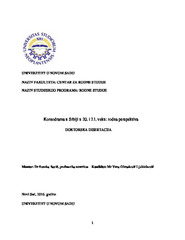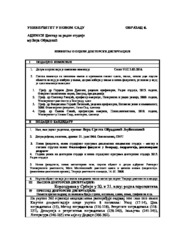Приказ основних података о дисертацији
Koreodrama u Srbiji u 20. i 21. veku: rodna perspektiva
Choreodrama in Serbia in the 20th and 21th Century: Gender Perspective
| dc.contributor.advisor | Savić, Svenka | |
| dc.contributor.other | Duhaček, Gordana Daša | |
| dc.contributor.other | Rapajić, Svetozar | |
| dc.contributor.other | Gordic-Petkovic, Vladislava | |
| dc.contributor.other | Savić, Svenka | |
| dc.creator | Obradović Ljubinković, Vera | |
| dc.date.accessioned | 2017-03-18T19:55:39Z | |
| dc.date.available | 2017-03-18T19:55:39Z | |
| dc.date.available | 2020-07-03T13:49:50Z | |
| dc.date.issued | 2016-06-04 | |
| dc.identifier.uri | https://nardus.mpn.gov.rs/handle/123456789/7755 | |
| dc.identifier.uri | http://www.cris.uns.ac.rs/DownloadFileServlet/Disertacija145762127774157.pdf?controlNumber=(BISIS)100277&fileName=145762127774157.pdf&id=5055&source=NaRDuS&language=sr | sr |
| dc.identifier.uri | http://www.cris.uns.ac.rs/record.jsf?recordId=100277&source=NaRDuS&language=sr | sr |
| dc.identifier.uri | http://www.cris.uns.ac.rs/DownloadFileServlet/IzvestajKomisije145762128528855.pdf?controlNumber=(BISIS)100277&fileName=145762128528855.pdf&id=5056&source=NaRDuS&language=sr | sr |
| dc.identifier.uri | null/DownloadFileServlet/IzvestajKomisije145762128528855.pdf?controlNumber=(BISIS)100277&fileName=145762128528855.pdf&id=5056 | |
| dc.description.abstract | Koreodrama je jedan od oblika pozorišne igre u kojoj se insistira na sintezi različitih oblika ispoljavanja: pokretom, muzikom, rečju. Ne postoji jedna definicija koreodrame s obzirom na vreme kada se pojavila i na umetničke i društvene prilike u kojima su pojedine snažne koreografske ličnosti stvarale do danas u svetu i Srbiji. Istražuju se praktične i teorijske dimenzije koreodrame kao zasebnog pozorišnog žanra sa stanovišta forme koja doprinosi razvoju rodnih studija, pre svega diskusijom o emancipaciji ženskog tela. Cilj ovoga rada je da prikupi, sistematizuje i interpretira podatke o razvoju koreodrame u Srbiji tokom 20. veka i njenom vidljivom prodoru u pozorišnoj umetnosti 21. veka - kako bi se jasno pokazale zasluge žena u afirmaciji ovog pozorišnog usmerenja. Hipoteza je da je koreodrama izmenila odnos prema igri, odnos prema drami i odnos prema ženskom telu. Savremene teorija roda vode računa o osobinama identiteta žena (i muškaraca) i tumače ga kao promenljivu pojavu kompleksnog sadržaja, sastavljenu od više različitih komponenata (Duhaček, 2011; 2014). U tumačenju osobina identiteta četiri odabrane umetnice koristimo holistički teorijski pristup savremenih teorija (poststrukturalni, postmoderni i interkulturalni feminizam), a metodom analize diskursa takav teorijski pristup proveravamo. Takav teorijski pristup uzima u obzir ne samo verbalnu poruku, nego podjednako i kontekst u kojem se verbalni i neverbalni događaj ispoljava i same sagovornike. Promenljivost identiteta je osnova ovakvog teorijskog pristupa, dokumentovana na empirijskom materijalu života i stvaralaštva umetnica u Srbiji u 20. veku. Metod istraživanja se oslanja na analizu teksta, odnosno dva su osnovna metoda (Savić, 1993): analiza tekstova i analiza razgovora (diskursa). Rezultati pokazuju da su se u Srbiji koreodramom bavile uglavnom umetnice izrazite individualnosti i obrazovanja, o kojima je samo delimično pisano u domaćoj literaturi kada je u pitanju odnos roda i koreodramskog postupka stvaranja, odabiranja sadržaja i afirmisanja u javnom prostoru: Maga Magazinović, Smiljana Mandukić, Nada Kokotović i Sonja Vukićević. 1.Vlastitim umetničkim i pedagoškim delovanjem naše četri umetnice doprinele su širenju znanja o igri u Srbiji uopšte, posebno novom poimanju oslobođenog tela (i to ne samo u igri); 2 Njihov doprinos se ogleda u ukupnoj emancipaciji žena (u profesiji, u porodici i dr.); 3. Sada je poznato da je uporedo tekla borba za ravnopravnost žena u društvu sa afirmacijom moderne igre i koreodrame u Srbiji. 4. Rad četiri umetnice je uticao na formiranje stvarateljki nove generacije koreografkinja u Srbiji u 21. veku. Zaključujem da postoji kontinuitet u afirmisanju žanra koreodrame u pozorišnom životu Srbije od periferije ka centru umetničkog događanja. Podaci iz ovog istraživanja se mogu neposredno uključiti u postojeće kurikulume o savremenoj igri na Akademiji umetnosti, s jedne strane, i u obrazovni program iz muzičke i pozorišne umetnosti u srednjim školama, s druge strane. | sr |
| dc.description.abstract | Choreodrama is a form of theatrical dance which insists on the synthesis of different forms of expression: movement, music, word. There is not a unique definition of choreodrama given the time when it appeared on the artistic and social situation in which some strong choreographic personalities have created to this date in the world and Serbia as well. The practical and theoretical dimensions of choreodrama as a separate genre are examined from the standpoint of form which contributes the development of gender studies, especially the discussion on the emancipation of the female body. The aim of this study is to gather, systematize and interpret information on the development of choreodrama in Serbia during the 20th century and its visible breakthrough in the art of theatre of the 21st century - in order to clearly show the merits of women in the promotion of this theatrical direction. The hypothesis is that choreodrama has changed attitude towards dance, the attitude towards drama and relationship to the female body. Contemporary theories of gender pay special attention on the characteristics of women' identity (and men' as well) and interpret it as the emergence of a complex variable content made up of several different components (Duhacek, 2011; 2014). In identity characterics interpreting of four selected artists we use a holistic theoretical approach to contemporary theories (poststructural, postmodern feminism and intercultural feminism) and this theoretical approach can be checked by method of discourse analysis. Such an approach takes into account not only the verbal message, but also the context in which the verbal and non-verbal situations are manifested, as well as interlocutors themselves. Variability of identity is the basis of this theoretical approach, documented in the empirical material of the female artists' lives and work in Serbia in the 20th century. The research method relies on the analysis of the text or, to be precise, two basic methods (Savić, 1993): analysis of texts and conversation analysis (discourse). The results show that in Serbia mainly female artists of great individuality and education dealt with choreodrama and they were only partly written about in our literature concerning the relationship of gender and choreodrama process of creation, selection of content and affirmation in the public area: Maga Magazinović, Smiljana Mandukić, Nada Kokotović and Sonja Vukicevic. 1.With their personal artistic and pedagogical functioning, our four women artists have contributed to spreading the knowledge about dance in Serbia in general, especially the new understanding of the liberated body (and not only in dance); 2. Their contribution is reflected in the total emancipation of women (in their profession, family, etc.); 3Now it is known that the struggle for women's equality in society was lead simultaneously with the affirmation of the modern dance and choreodrama in Serbia. 4. The work of these four female artists has influenced the work of the creators of a new generation of choreographers in Serbia in the 21st century. I conclude that there is continuity in the promotion of the choreodrama genre in Serbian theatrical life from the periphery to the center of artistic events. The research information can be directly incorporated into existing curricula of contemporary art at the Academies of Arts, on the one hand, and in the educational programme of music and theatrical art in secondary schools, on the other hand. | en |
| dc.language | sr (latin script) | |
| dc.publisher | Универзитет у Новом Саду, Студије при универзитету | sr |
| dc.rights | openAccess | en |
| dc.rights.uri | https://creativecommons.org/licenses/by-nc-sa/4.0/ | |
| dc.source | Универзитет у Новом Саду | sr |
| dc.subject | Rodne studije | sr |
| dc.subject | Gender studies | en |
| dc.subject | choreodrama | en |
| dc.subject | modern dance | en |
| dc.subject | free dance | en |
| dc.subject | body | en |
| dc.subject | female body | en |
| dc.subject | koreodrama | sr |
| dc.subject | moderna igra | sr |
| dc.subject | slobodna igra | sr |
| dc.subject | telo | sr |
| dc.subject | žensko telo | sr |
| dc.title | Koreodrama u Srbiji u 20. i 21. veku: rodna perspektiva | sr |
| dc.title.alternative | Choreodrama in Serbia in the 20th and 21th Century: Gender Perspective | en |
| dc.type | doctoralThesis | en |
| dc.rights.license | BY-NC-SA | |
| dcterms.abstract | Савић, Свенка; Рапајић, Светозар; Савић, Свенка; Даша Духачек, Гордана; Гордиц-Петковиц, Владислава; Обрадовић Љубинковић, Вера; Кореодрама у Србији у 20. и 21. веку: родна перспектива; Кореодрама у Србији у 20. и 21. веку: родна перспектива; | |
| dc.identifier.fulltext | https://nardus.mpn.gov.rs/bitstream/id/39515/Disertacija8050.pdf | |
| dc.identifier.fulltext | http://nardus.mpn.gov.rs/bitstream/id/39515/Disertacija8050.pdf | |
| dc.identifier.fulltext | http://nardus.mpn.gov.rs/bitstream/id/39516/IzvestajKomisije8050.pdf | |
| dc.identifier.fulltext | https://nardus.mpn.gov.rs/bitstream/id/39516/IzvestajKomisije8050.pdf | |
| dc.identifier.rcub | https://hdl.handle.net/21.15107/rcub_nardus_7755 |



